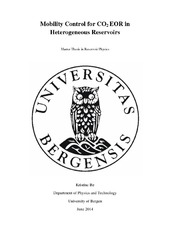| dc.description.abstract | This experimental thesis investigates enhanced oil recovery (EOR) by secondary and tertiary CO2 and/or CO2-foam injections at miscible conditions in fractured and whole core plugs using different rock types. Injection of CO2 for EOR has in recent years received increased attention because it may 1) reduce CO2 concentration in the atmosphere to reduce global warming, and 2) significantly improved oil recovery. A major challenge is the low viscosity of the injected CO2, which may lead to poor sweep efficiency and low oil recovery. Poor sweep is a general challenge in fractured reservoirs, where the fractures control flow and matrix blocks are saturated with oil. Mobility control by the use of CO2-foam will increase the apparent gas viscosity and provide a more favorable mobility ratio and lead to incremental oil recovery by adding a viscous component to the transport of CO2 from the fracture to the matrix. Laboratory experiments have been carried out on Portland chalk cores and Edward limestone cores, as analogues to reservoir rocks, in addition to reservoir cores. From a total of 52 cores prepared, 28 cores were used for CO2 and/or CO2 foam injections conducted with different setups that was designed tested and used, located in three different laboratories: Department of Physics and Technology, Haukeland University Hospital and Texas A&M University. Secondary miscible CO2 and CO2-foam flooding experiments were performed on both fractured and non-fractured, strongly water-wet core material to study recovery performance. Mineral oil was used in all experiments to ensure miscibility with CO2, at both liquid and supercritical conditions. Eight supercritical CO2 experiments were conducted in strongly water-wet fractured and non-fractured Edward limestone and Portland chalk outcrops. Results showed high recoveries in the range of 81.5 - 89.9 % of OOIP for the whole cores and lower recoveries in the range of 57.5 - 68.4 % of OOIP for the fractured cores. Less amount of CO2 was required to reach end point oil saturation in the whole cores compared to the fractured cores. To investigate if the recovery performance by CO2 diffusion could be improved in a fractured system a subsequent CO2-foam injection for mobility control were conducted in six additional experiments. The results from experiments in Edward limestone cores suggested that strong foam is generated and accelerated the oil production, whereas no significant effect was observed in the Portland chalk. General observations from the secondary CO2 and CO2-foam injection indicate that oil recovery by diffusion is more prominent in chalk material and foam is more efficient in limestone material, suspected to be caused by differences in pore characteristics. Integrated EOR, by combing proven EOR methods in a smart sequence, was evaluated in strongly water-wet, fractured limestone cores at supercritical conditions. The core plugs were first waterflooded, then CO2-injection and subsequent CO2-foam injections were performed. The oil recovery was increased for each injection step, and an accelerated oil recovery was observed during CO2-foam injections due to in-situ generation of foam in fractured systems. Tertiary CO2 injections were also performed in unpreserved reservoir cores from a heterogeneous carbonate field in the USA, leading to an oil recovery above 90% of OOIP. A “best practice” was developed to measure permeability using CO2 and re-saturate unpreserved reservoir shale core plugs with crude oil. Using PET/CT, shale rock structure and flow behavior during CO2 injections were evaluated. | en_US |
